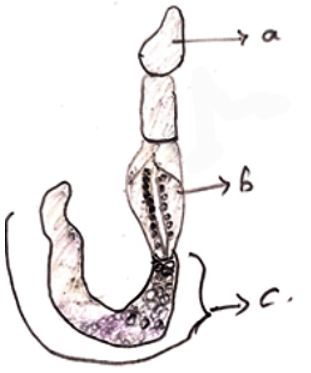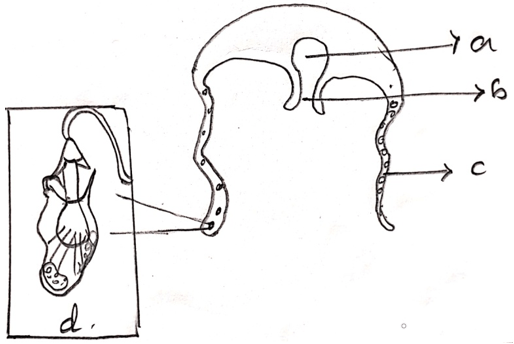This set of Class 11 Biology Chapter 4 Multiple Choice Questions & Answers (MCQs) focuses on “Classification of Animal Kingdom into Different Phylum-4”.
1. Which among the following is incorrect about Mollusca?
a) This is the second largest phylum of Animal Kingdom
b) They have organ system level of organization
c) They have a dorsal heart along with dorsal and ventral blood vessels
d) Their body is covered with calcareous shell
View Answer
Explanation: Mollusks constitute the second largest phylum of Animal kingdom. They have organ system level of organization. They have open type of circulatory system. Their body is covered with calcareous shell.
2. Which among the following statements is incorrect about nervous system in Mollusca?
a) Ganglia are present at important parts of body
b) All the mollusks exhibit cephalization
c) Many of them have eyespots that act as photoreceptors
d) The anterior head region has sensory tentacles that help in sense of touch
View Answer
Explanation: Most of the mollusks don’t exhibit cephalization. Ganglia are present at important parts of their body. Many of them have eyespots that act as photoreceptors. The anterior head region has sensory tentacles that help in sense of touch.
3. The soft spongy layer of skin over the hump is called as ________
a) Visceral Hump
b) Mantle
c) Radula
d) Foot
View Answer
Explanation: The soft spongy layer of skin over the hump is called Mantle. The gap between hump and the mantle is called mantle cavity. In some mollusks, mantle cavity acts as the respiratory organs of the body.
4. Which among the following is not correct about organ systems in mollusks?
a) Pair of main nerve cords extends throughout their body
b) Mollusks respire either through gills or mantle cavity
c) Excretion occurs through malpighian tubules
d) They have an open type of circulatory system
View Answer
Explanation: Pair of main nerve cords extends throughout their body. Mollusks respire either through gills or mantle cavity. Excretion occurs through nephridia. They have an open type of circulatory system.
5. Mollusks have a file like rasping organ called as radula that helps them in catching prey
a) True
b) False
View Answer
Explanation: Mollusks have a file like rasping organ called as radula that helps them in catching prey. Mollusks have ganglia at important parts of their body which helps them perform important functions.
6. Which among the following is incorrect about Echinodermata?
a) The word “Echino” means spiny and “dermata” means skinned
b) Echinoderms are dioecious with fertilization being external in most cases
c) They have a central nerve ring that extends throughout their body
d) The circulatory system is closed and they have a heart along with blood vessels
View Answer
Explanation: The word “Echino” means spiny and “dermata” means skinned. Echinoderms are dioecious with fertilization being external in most cases. They have a central nerve ring that extends throughout their body. The circulatory system in Echinoderms is of open type.
7. Which among the following is incorrect about water vascular system in Echinoderms?
a) Water driven tube feet system helps in locomotion as well as in excretion
b) Water vascular system has a ring canal which fills initially followed by that of radial canals
c) Echinoderms excrete waste by osmosis in the tube feet
d) Exchange of gases takes place due to water vascular system
View Answer
Explanation: Water driven tube feet system helps in locomotion as well as in excretion. Water vascular system has a ring canal which fills initially followed by that of radial canals. Echinoderms excrete waste by diffusion through the tube feet. Exchange of gases takes place due to water vascular system.
8. Which among the following is incorrect about Echinoderms?
a) Larval stage is bilaterally symmetrical and adults are radially symmetrical
b) They are dioecious and most of the times the fertilization is external
c) The larvae is immobile and bilaterally symmetrical
d) They have a complete digestive system with mouth on the ventral side and anus on the dorsal side
View Answer
Explanation: Larval stage is bilaterally symmetrical and adults are radially symmetrical. They are dioecious and most of the times the fertilization is external. The larvae is immobile and bilaterally symmetrical. They have a complete digestive system with mouth on the ventral side and anus on the dorsal side.
9. Which among the following is incorrect about nervous system in Echinodermata?
a) Radial nerves extend through the arms from the central nerve ring that surrounds the mouth
b) Sensory tentacles help in sense of touch
c) Epidermis contains sensory cells that help in sense of touch
d) Their brain is made up of 4 nerve rings
View Answer
Explanation: Radial nerves extend through the arms from the central nerve ring that surrounds the mouth. Sensory tentacles help in sense of touch. Epidermis contains sensory cells that help in sense of touch. In Echinoderms, brain is absent.
10. Which among the following is incorrect about Hemichordata?
a) They have three main parts in their body, namely, Proboscis, Collar and a long trunk
b) Open circulatory system is present in these organisms
c) Excretion takes place through proboscis gland
d) Hemichordates are organisms that contain notochord like chordates but lack in all other features
View Answer
Explanation: Hemichordates have three main parts in their body, namely, Proboscis, Collar and a long trunk. Open circulatory system is present in these organisms. Excretion takes place through proboscis gland. Hemichordates don’t have a notochord instead have a structure similar to notochord called as stomochord.
11. Which among the following is incorrect about Hemichordates?
a) Their digestive system is complete with both mouth and anus
b) They are bilaterally symmetrical and are coelomates
c) They adopt tracheal mode of respiration
d) These organisms are also called as acorn worms
View Answer
Explanation: The digestive system in hemichordates is complete with both mouth and anus. They are bilaterally symmetrical and are coelomates. They use their gills to respire. These organisms are also called as acorn worms.
12. Which among the following statements is incorrect about Hemichordates?
a) Embryo development is indirect i.e. they have an intermediate larval stage
b) The circulatory system is of closed type i.e. they have a dorsal heart and blood vessels
c) They have dorsal and ventral nerves that help in coordination
d) They are monoecious
View Answer
Explanation: Embryo development is indirect i.e. they have an intermediate larval stage. The circulatory system is of closed type i.e. they have a dorsal heart and blood vessels. They have dorsal and ventral nerves that help in coordination. They are dioecious.
13. Which among the following is correct about the following diagram?

a) a – helps in excretion; b-has mouth and helps in peristalsis of food; c-has gills and helps in respiration
b) a – mouth and helps in peristalsis of food; b – has gills and helps in respiration; c – has brain and central nervous system
c) a – helps in excretion; b – has gills and helps in respiration; c – has mouth and helps in peristalsis of food
d) a – has mouth and helps in peristalsis of food; b – has brain and central nervous system; c – helps in excretion
View Answer
Explanation: Hemichordates have three main body parts. They are Proboscis, Collar and Trunk. Proboscis helps in excretion. Collar has a mouth and helps in peristalsis of food. Trunk has gills and helps in respiration.
14. Which among the following statements is incorrect about the following diagram?

a) The above figure shows medusa
b) “d” has stingy capsules that help in catching prey
c) “b” helps in ingesting food
d) “a” is the cavity between gut wall and body wall
View Answer
Explanation: The above figure shows medusa. In the above diagram, a, b, c, d indicates gastro-vascular cavity, hypostome, tentacles and cnidoblasts respectively. Cnidoblasts have stingy capsules that help in catching prey.
Sanfoundry Global Education & Learning Series – Biology – Class 11.
To practice all chapters and topics of class 11 Biology, here is complete set of 1000+ Multiple Choice Questions and Answers.
If you find a mistake in question / option / answer, kindly take a screenshot and email to [email protected]
- Practice Class 12 - Biology MCQs
- Practice Class 11 - Chemistry MCQs
- Practice Class 11 - Mathematics MCQs
- Check Class 11 - Books
- Practice Class 11 - Physics MCQs
